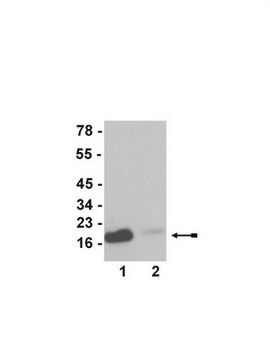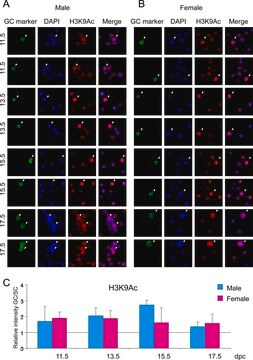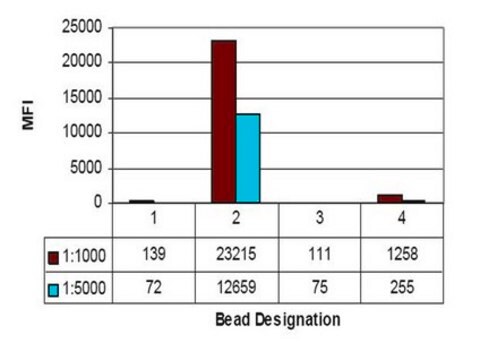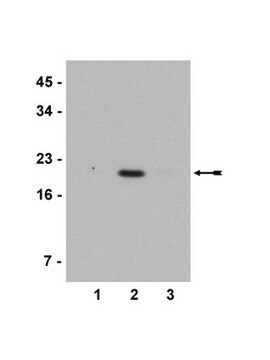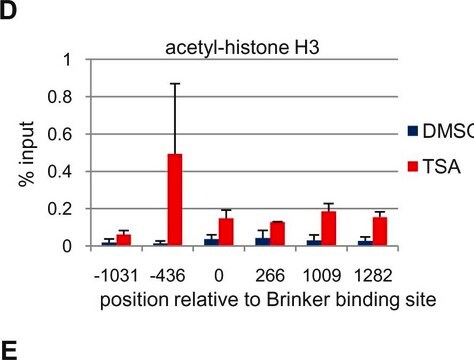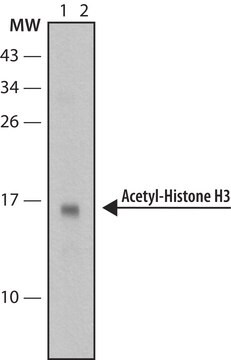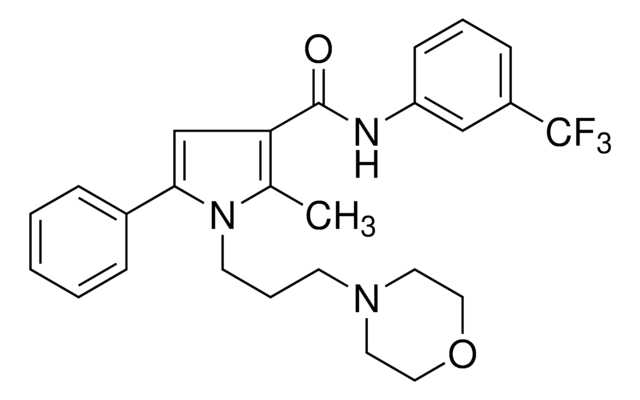ABE18
Anti-acetyl Histone H3 (Lys9) Antibody
from rabbit, purified by affinity chromatography
Sinonimo/i:
H3 histone family, member T, histone 3, H3, histone cluster 3, H3, H3K4ac
About This Item
Prodotti consigliati
Origine biologica
rabbit
Livello qualitativo
Forma dell’anticorpo
affinity isolated antibody
Tipo di anticorpo
primary antibodies
Clone
polyclonal
Purificato mediante
affinity chromatography
Reattività contro le specie
chicken, human, mouse
tecniche
ChIP: suitable (ChIP-seq)
dot blot: suitable
multiplexing: suitable
western blot: suitable
N° accesso NCBI
N° accesso UniProt
Condizioni di spedizione
wet ice
modifica post-traduzionali bersaglio
acetylation (Lys9)
Informazioni sul gene
human ... HIST1H3F(8968)
Descrizione generale
Specificità
Immunogeno
Applicazioni
A representative lot of this antibody immunoprecipitated chromatin from Histone H3 acetylated on Lys9.
ChIP-Sequencing:
Chromatin immunoprecipitation was performed using the Magna ChIP HiSens kit (cat# 17-10460), 2 μg of a representative lot of anti-acetyl-Histone H3 (Lys9) antibody (ABE18), 20μL Protein A/G beads, and 1e6 crosslinked HeLa cell chromatin followed by DNA purification using magnetic beads. Libraries were prepared from Input and ChIP DNA samples using standard protocols with Illumina barcoded adapters, and analyzed on Illumina HiSeq instrument. An excess of thirteen million reads from FastQ files were mapped using Bowtie(http://bowtie-bio.sourceforge.net/manual.shtml) following TagDust (http://genome.gsc.riken.jp/osc/english/dataresource/) tag removal. Peaks were identified using MACS (http://luelab.dfci.harvard.edu/MACS/), with peaks and reads visualized as a custom track in UCSC Genome Browser (http://genome.ucsc.edu) from BigWig and BED files.
Dot Blot Analysis:
A representative lot pf this antibody detected Histone H3 in modified and non modified peptides of acetylated and non-acetylated Histone H3 Lys9.
Luminex Analysis:
A representative lot of this antibody specifically recognized Histone H3 acetylated on Lys9 by Luminex assay.
Epigenetics & Nuclear Function
Histones
Qualità
Western Blot Analysis: 0.05 µg/mL of this antibody detected Histone H3 on 10 µg of sodium butyrate untreated and treated HeLa acid extract.
Descrizione del bersaglio
Stato fisico
Stoccaggio e stabilità
Risultati analitici
Sodium butyrate untreated and treated HeLa acid extract
Altre note
Esclusione di responsabilità
Non trovi il prodotto giusto?
Prova il nostro Motore di ricerca dei prodotti.
Codice della classe di stoccaggio
12 - Non Combustible Liquids
Classe di pericolosità dell'acqua (WGK)
WGK 1
Punto d’infiammabilità (°F)
Not applicable
Punto d’infiammabilità (°C)
Not applicable
Certificati d'analisi (COA)
Cerca il Certificati d'analisi (COA) digitando il numero di lotto/batch corrispondente. I numeri di lotto o di batch sono stampati sull'etichetta dei prodotti dopo la parola ‘Lotto’ o ‘Batch’.
Possiedi già questo prodotto?
I documenti relativi ai prodotti acquistati recentemente sono disponibili nell’Archivio dei documenti.
Il team dei nostri ricercatori vanta grande esperienza in tutte le aree della ricerca quali Life Science, scienza dei materiali, sintesi chimica, cromatografia, discipline analitiche, ecc..
Contatta l'Assistenza Tecnica.
